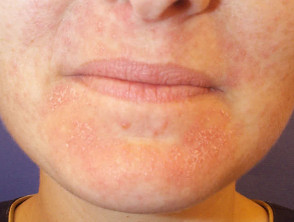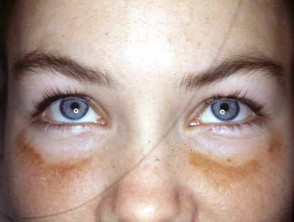DermNet provides Google Translate, a free machine translation service. Note that this may not provide an exact translation in all languages
Home Follicular disorders Topical treatment for acne CME
Follicular disorders
Topical therapy for acne
Created 2009.
Learning objectives
- Prescribe topical therapy for acne safely and appropriately
Introduction
Topical therapy is used alone in mild facial skin conditions, and combined with oral antibiotics if more severe. As it may take weeks to months to notice improvement, it should be applied to all the areas that are affected by the skin condition and continued until the condition has resolved.
Topical therapy for acne includes:
- Topical retinoids
- Benzoyl peroxide
- Azelaic acid
- Topical antibiotics
- Others
Adverse effects of topical agents
Dryness of the treated area can be expected and is usually mild. If the skin is visibly scaly, apply a light non-oily moisturizer.
Skin irritation is rarely severe. Occasionally, irritation means that product must be discontinued. Lotions are less likely than solutions or gels to cause irritation. The latter are more likely to be preferred in those with very oily skin.
Contact dermatitis can be due to irritancy or allergy. It can be treated with hydrocortisone cream.
Adverse effects of topical acne treatment
Topical retinoids
Retinoids (vitamin A derivatives) are defined by their ability to bind nuclear retinoid receptors. They control cellular proliferation and differentiation.
Available topical retinoids include:
- Retinol
- Retinaldehyde
- Tretinoin
- Isotretinoin
- Adapalene
Tretinoin, isotretinoin and adapalene are prescription medicines for the treatment of acne with particularly useful effect on comedones. Continued use generally also reduces inflammatory lesions in acne and rosacea but initially they may appear to aggravate these.
Topical retinoids (prescribed and over-the-counter) are also useful to reverse photoageing. They peel off and lighten pigmented lesions (lentigines) and reduce fine surface wrinkles by preventing loss of collagen from, and stimulating new collagen formation in, the papillary dermis. They have a similar but less obvious effect on aged skin in non sun-exposed sites.
Topical retinoids can be applied to any area but are most often used on the face, the neck and the back of hands. They frequently irritate and may increase the risk of sunburn. Excessive use results in redness and peeling. These effects can be minimised by using a minimal amount on alternate nights at first and if necessary applying a light oil-free moisturiser.
There is continuing controversy whether the topical use of tretinoin, isotretinoin and adapalene could cause birth deformities so they should not be prescribed in pregnancy. However increase in serum retinoids has not been demonstrated after topical use.
Benzoyl peroxide
Benzoyl peroxide is a commonly used topical treatment for mild to moderate acne and is readily available. It is safe for adults and children, and can be used in pregnancy.
Benzoyl peroxide has the following properties:
- Antiseptic: it does not cause bacterial resistance and in fact can reduce bacterial resistance if this has arisen from antibiotic therapy;
- Oxidizing agent – this makes it keratolytic and comedolytic;
- Anti-inflammatory.
Benzoyl peroxide is available as cream, gel, lotion and wash at concentrations of 2.5%, 5% and 10%. It may be combined with other topical or oral therapy.
In New Zealand, products containing benzoyl peroxide are available without prescription. Some of these are listed in the New Ethicals catalogue.
How to use benzoyl peroxide products:
Make sure the skin is clean and dry before applying;
- Apply a thin smear initially every second night, then build up to once or twice daily as tolerated;
- It can be used on the trunk as well as the face.
- Make sure the benzoyl peroxide has completely dried before the treated skin touches clothes or bedding as it can bleach fabrics.
Azelaic acid
Azelaic acid is a natural material produced by Malassezia yeasts, and is a normal dietary constituent. It is available over-the-counter as a 20% cream and lotion to treat mild comedonal and inflammatory acne.
It is antibacterial, keratolytic, comedolytic and anti-inflammatory.
Azelaic acid also reduces pigmentation, so it's particularly useful for darker skinned patients whose acne spots leave persistent brown marks or who have melasma.
The cream should be applied to the area affected by acne initially daily, then if tolerated building up to a generous twice-daily application after thoroughly cleansing the skin.
Azelaic acid is nontoxic and is well tolerated by most subjects. However, atopics and others with sensitive skin may find it irritating.
Topical antibiotics
Antibiotics reduce the number of Cutibacterium acnes on the skin surface and in the follicles and also have an anti-inflammatory action.
Topical antibiotics marked for acne contain clindamycin or erythromycin as a lotion, solution or gel. They should be applied once or twice daily, preferably while also using another acne agent such as benzoyl peroxide or topical retinoid. However, combined use may result in a cumulative irritant effect.
These topical antibiotics are not on the Pharmaceutical Schedule in New Zealand so they are not subsidised. Topical antibiotics should not be used when patients are prescribed oral antibiotics, to reduce the chance of bacterial resistance.
Other topical agents
Salicylic acid, sulphur, sulphacetamide, resorcinol and alpha-hydroxy acids are present in many over-the-counter preparations for acne. Various combinations have comedolytic, keratolytic and anti-inflammatory effects but there is little published evidence to support their use.
Activity
Discuss the development of bacterial resistance due to topical antibiotics for acne. How should this be managed?
Related information
References:
On DermNet NZ:
Information for patients
Other websites:
- Medscape:
- Treatment of Facial Acne Journal Watch Dermatology, February 2, 2005
- Antibiotic Resistance of Propionibacterium acnes in Acne Vulgaris From Dermatology Nursing, September 15, 2003
- Clinical Review: Topical Retinoids From Dermatology Nursing, December 5, 2003
- Topical Retinoids in Primary Care Practice CME activity, July 30, 2005
- Journal of German Society of Dermatology: Acne therapy with topical benzoyl peroxide, antibiotics and azelaic acid April 2006
Books about skin diseases:
See the DermNet NZ bookstore
Sign up to the newsletter
© 2024 DermNet.
DermNet does not provide an online consultation service. If you have any concerns with your skin or its treatment, see a dermatologist for advice.

